
A sausage is a type of meat product usually made from ground meat—often pork, beef, or poultry—along with salt, spices and other flavourings. Other ingredients, such as grains or breadcrumbs, may be included as fillers or extenders.

Head cheese or brawn is a cold cut terrine or meat jelly that originated in Europe, perhaps ancient Germania. It is made with flesh from the head of a calf or pig, typically set in aspic, and usually eaten cold, at room temperature, or in a sandwich. Despite its name, the dish is not a cheese and contains no dairy products. The parts of the head used vary, and may include the tongue but do not commonly include the brain, eyes or ears. Trimmings from more commonly eaten cuts of pork and veal are often used, and sometimes the feet and heart, with gelatin added as a binder.

Tripe is a type of edible lining from the stomachs of various farm animals. Most tripe is from cattle, pigs and sheep.

A blood sausage is a sausage filled with blood that is cooked or dried and mixed with a filler until it is thick enough to solidify when cooled. Most commonly, the blood of pigs, sheep, lamb, cow, chicken, or goose is used.

Scrapple, also known by the Pennsylvania Dutch name Pannhaas, is a traditional mush of fried pork scraps and trimmings combined with cornmeal and wheat flour, often buckwheat flour, and spices.

Offal, also called variety meats, pluck or organ meats, is the internal organs of a butchered animal. The word does not refer to a particular list of edible organs, and these lists of organs vary with culture and region, but usually exclude skeletal muscle. Offal may also refer to the by-products of milled grains, such as corn or wheat.
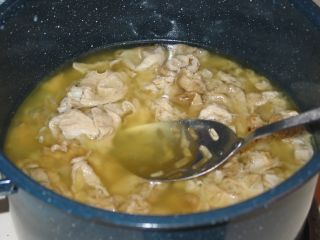
Chitterlings, sometimes spelled chitlins or chittlins, are the large intestines of domestic animals. They are usually made from pigs' intestines. They may also be filled with a forcemeat to make sausage. Intestine from other animals, such as cow, lamb, goose, and goat is also used for making chitterling.

White pudding, oatmeal pudding or mealy pudding is a meat dish popular in the British Isles.

Red pudding is a meat dish served mainly at chip shops in some areas of Scotland. Red pudding is associated with the east of Scotland, particularly Fife, but has become less common in recent years. Its main ingredients are beef, pork, pork rind or bacon, suet, rusk, wheat flour, spices, salt, beef fat and colouring.

Peasant foods are dishes eaten by peasants, made from accessible and inexpensive ingredients.

Pease pudding, also known as pease porridge, is a savoury pudding dish made of boiled legumes, typically split yellow peas, with water, salt and spices, and often cooked with a bacon or ham joint. A common dish in the north-east of England, it is consumed to a lesser extent in the rest of Britain. In Newfoundland, it retains its traditional name as part of the customary Jiggs dinner. In non-English speaking countries, similar dishes exist under different names.
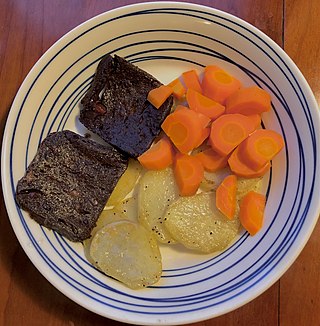
Balkenbrij is a traditional Dutch food that shares some of the characteristics of American scrapple. Traditionally, its preparation and consumption was an important economizing custom, especially for the rural poor. Particularly, it allowed farmers to use various less-desirable parts of pork, which were made more palatable by being added to a seasoned porridge of groats or flour. The closely related 'Panhas', 'Pannas' or 'Möppkenbrot' are widely known in the whole northwest of Germany; the last variety is a speciality of middle Westphalia and Rhineland.

Scottish cuisine encompasses the cooking styles, traditions and recipes associated with Scotland. It has distinctive attributes and recipes of its own, but also shares much with other British and wider European cuisine as a result of local, regional, and continental influences—both ancient and modern.

A full breakfast is a substantial cooked breakfast meal, often served in Great Britain and Ireland. The typical ingredients are bacon, sausages, eggs, black pudding, baked beans, tomatoes, mushrooms and fried bread with toast and a beverage such as coffee or tea served on the side. Hash browns are a common contemporary but non-traditional inclusion. Ingredients may extend beyond these or include regional variants, which may often be referred to by different names depending on the area. While it is colloquially known as a "fry-up" in most areas of the United Kingdom and Ireland, it is usually referred to as a "full English", a "full Irish", "full Scottish", "full Welsh", and "Ulster fry", in England, the Republic of Ireland, Scotland, Wales, and Northern Ireland, respectively.
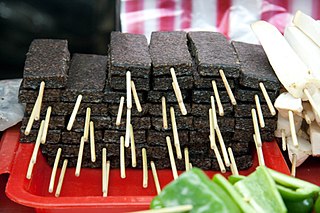
Blood as food is the usage of blood in food, religiously and culturally. Many cultures consume blood, often in combination with meat. The blood may be in the form of blood sausage, as a thickener for sauces, a cured salted form for times of food scarcity, or in a blood soup. This is a product from domesticated animals, obtained at a place and time where the blood can run into a container and be swiftly consumed or processed. In many cultures, the animal is slaughtered. In some cultures, blood is a taboo food.

Stippgrütze, also called Wurstebrei, is a German dish from Westphalia which is similar to Grützwurst or Knipp. It consists of barley groats cooked in sausage juices (Wurstbrühe), which are enriched with pieces of meat, offal, such as heart, kidney or liver and seasoned with spices and salt. More rarely, finely chopped onions are added. The cooked ingredients are minced after the juices have been poured off and a crumbly cake is left which is held together with fat and which sets on cooling. There are various recipes, but they all contain barley groats, fat and meat.

Drob, fully named Drob de Miel or Drob de Paște, is a traditional Romanian dish of lamb offals, green onions, herbs, eggs, and bread soaked in water or milk. The boiled offals are chopped and mixed with all the other ingredients and seasoned with salt and pepper. The caul of the lamb is stretched over a loaf pan and filled with the mixture.
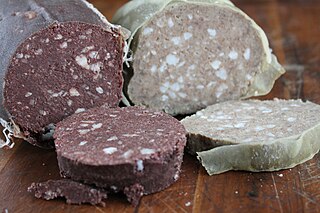
Slátur is an Icelandic food made from the innards of sheep. There are two types of slátur; blóðmör (Icelandic) or "blood pudding" and lifrarpylsa. The first is similar to Irish and British black pudding, although it does not contain the spices used in British and Irish cuisine. They are also much smoother in texture.

Black pudding is a distinct regional type of blood sausage originating in the United Kingdom and Ireland. It is made from pork or occasionally beef blood, with pork fat or beef suet, and a cereal, usually oatmeal, oat groats, or barley groats. The high proportion of cereal, along with the use of certain herbs such as pennyroyal, serves to distinguish black pudding from blood sausages eaten in other parts of the world.
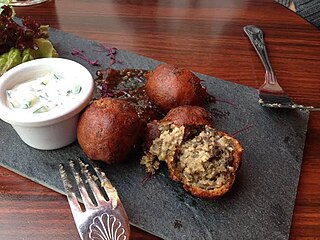
Haggis pakora is a Scottish snack food that combines traditional Scottish haggis ingredients with the spices, batter and preparation method of Indian and Pakistani pakoras. It has become a popular food in Indian and Pakistani restaurants in Scotland, and is also available in prepared form in supermarkets.



























